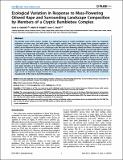| dc.contributor.author | Stanley, Dara A. | |
| dc.contributor.author | Knight, Mairi E. | |
| dc.contributor.author | Stout, Jane C. | |
| dc.date.accessioned | 2017-05-09T13:26:01Z | |
| dc.date.available | 2017-05-09T13:26:01Z | |
| dc.date.issued | 2013-06-19 | |
| dc.identifier.citation | Stanley DA, Knight ME, Stout JC (2013) Ecological Variation in Response to Mass-Flowering Oilseed Rape and Surrounding Landscape Composition by Members of a Cryptic Bumblebee Complex. PLoS ONE 8(6): e65516. https://doi.org/10.1371/journal.pone.0065516 | en_IE |
| dc.identifier.issn | 1932-6203 | |
| dc.identifier.uri | http://hdl.handle.net/10379/6503 | |
| dc.description.abstract | The Bombus sensu stricto species complex is a widespread group of cryptic bumblebee species which are important pollinators of many crops and wild plants. These cryptic species have, until now, largely been grouped together in ecological studies, and so little is known about their individual colony densities, foraging ranges or habitat requirements, which can be influenced by land use at a landscape scale. We used mass-flowering oilseed rape fields as locations to sample bees of this complex, as well as the second most common visitor to oilseed rape B. lapidarius, and molecular RFLP methods to distinguish between the cryptic species. We then used microsatellite genotyping to identify sisters and estimate colony densities, and related both proportions of cryptic species and their colony densities to the composition of the landscape surrounding the fields. We found B. lucorum was the most common member of the complex present in oilseed rape followed by B. terrestris. B. cryptarum was also present in all but one site, with higher proportions found in the east of the study area. High numbers of bumblebee colonies were estimated to be using oilseed rape fields as a forage resource, with B. terrestris colony numbers higher than previous estimates from non-mass-flowering fields. We also found that the cryptic species responded differently to surrounding landscape composition: both relative proportions of B. cryptarum in samples and colony densities of B. lucorum were negatively associated with the amount of arable land in the landscape, while proportions and colony densities of other species did not respond to landscape variables at the scale measured. This suggests that the cryptic species have different ecological requirements (which may be scale-dependent) and that oilseed rape can be an important forage resource for many colonies of bumblebees. Given this, we recommend sustainable management of this crop to benefit bumblebees. | en_IE |
| dc.format | application/pdf | en_IE |
| dc.language.iso | en | en_IE |
| dc.publisher | Public Library of Science | en_IE |
| dc.relation.ispartof | Plos One | en |
| dc.rights | Attribution-NonCommercial-NoDerivs 3.0 Ireland | |
| dc.rights.uri | https://creativecommons.org/licenses/by-nc-nd/3.0/ie/ | |
| dc.subject | Cryptic speciation | en_IE |
| dc.subject | Rapeseed | en_IE |
| dc.subject | Bumblebees | en_IE |
| dc.subject | Foraging | en_IE |
| dc.subject | Bees | en_IE |
| dc.subject | Spatial and landscape ecology | en_IE |
| dc.subject | Conservation science | en_IE |
| dc.subject | Habitats | en_IE |
| dc.title | Ecological variation in response to mass-flowering oilseed rape and surrounding landscape composition by members of a cryptic bumblebee complex | en_IE |
| dc.type | Article | en_IE |
| dc.date.updated | 2017-04-27T14:58:07Z | |
| dc.identifier.doi | 10.1371/journal.pone.0065516 | |
| dc.local.publishedsource | https://doi.org/10.1371/journal.pone.0065516 | en_IE |
| dc.description.peer-reviewed | peer-reviewed | |
| dc.contributor.funder | |~| | |
| dc.internal.rssid | 11213321 | |
| dc.local.contact | Dara Stanley, Room 225, Ryan Institute, Botany And Plant Science, , School Of Natural Sciences, National University Of Ireland Galway. 3422 Email: dara.stanley@nuigalway.ie | |
| dc.local.copyrightchecked | No | |
| dc.local.version | PUBLISHED | |
| nui.item.downloads | 332 | |


